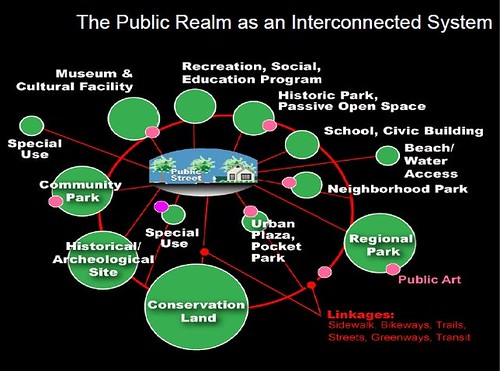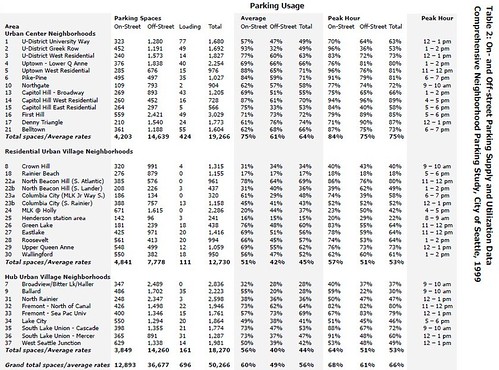City transportation departments need to set up innovation units
There is a fine line between blogging about experiences as whining or as indicators of the need for change and opportunities for improvement.
There are many opportunities for improvement.
I am participating in an action-research project comparing US arts-based revitalization programs to cases in Europe, which is a great opportunity for me to learn about perceived differences vis-a-vis Europe concerning "American attitudes" towards involvement, initiation, and self-help vs. the role of the state, state action, and the respect--or not--accorded to the role of the state within these processes.... and we have had some thought-provoking discussions on the role of civil society.
I have been meaning to write about this topic, and two concurrent triggers are:
(1) a colleague sent me a link to the online journal Nautilus and the current issue, which focuses on "transit" and includes an article by Tom Vanderbilt, author of the book Traffic, on route optimization programming and the various activities of UPS in this business- and logistics-space ("Unhappy truckers and other algorithmic problems") and
 (2) last week there was a piece in Greater Greater Washington ("Need to pick up a UPS package? The car-free are out of luck") about how UPS routes all the packages from missed deliveries to Landover, Maryland (unless you pay a fee for a redirect to a UPS store in DC), which is very difficult to get to, especially by transit (I've done it myself at least once).
(2) last week there was a piece in Greater Greater Washington ("Need to pick up a UPS package? The car-free are out of luck") about how UPS routes all the packages from missed deliveries to Landover, Maryland (unless you pay a fee for a redirect to a UPS store in DC), which is very difficult to get to, especially by transit (I've done it myself at least once).Something that bothered me about NACTO, the National Association of City Transportation Officials, is that the organization seems to be really focused on improving biking infrastructure, but not so much on taking up other necessary ideas, and translating them into policy and practice, in order to build a more robust soft and hard infrastructure for sustainable transportation.
Maybe I am wrong about that, given their upcoming Designing Cities conference. It seems as if they are expanding their practice and focus.
But still, I don't see city departments of transportation looking at particular mobility problems in innovative ways, with an eye towards transforming certain elements of transportation practice that don't involve construction or equipment purchase (streetscape, bicycle sharing, buses, streetcars) forward in more innovative ways. This is something that NACTO could help foster.
 And yes, there are many great examples of transportation departments being innovative concerning streetscape and parklets programs (especially New York City and San Francisco), and with various elements of transit.
And yes, there are many great examples of transportation departments being innovative concerning streetscape and parklets programs (especially New York City and San Francisco), and with various elements of transit. Right: Urban design placemaking on Broadway in New York City, New York Times photo.
Right now there are no good frameworks for doing this. There is great research conducted by transportation academics, but a lot of it doesn't percolate down to changes in practice.
Partly this is because there is no mechanism within the transportation innovation diffusion process for most non-engineering-related elements of transportation planning so that practical implementation can occur.
This diagram from the German National Bicycle Plan can be re-conceptualized more broadly in terms of creating an integrated system for sustainable mobility

Concept of the integrated public realm framework by David Barth and Carlos Perez of AECOM

For example, a few weeks ago I criticized a DDOT colleague over how DDOT basically ignored some of the more wide ranging transportation demand management ideas suggested in the ANC4B Large Tract Review Report on Walmart, 5/2011 such as:
• Walmart should provide a shuttle service between their store and the Georgia Avenue-Petworth Metro Station
• Walmart should offer delivery services for all transactions totaling at least $50.
• Walmart should make home delivery services a routine and standard part of their service offering in urban/center city store locations, not just at the Georgia Avenue location, but in all the stores in DC, and in other urban markets across the United States [they are testing this in San Jose, see "" from ]
• Walmart should agree to explore with the DC Department of Transportation setting up a shared parking situation with the on-site customer parking spaces, perhaps through the creation of a transportation management district” to manage this and other transportation demand management initiatives in both this and the Walter Reed commercial nodes on Georgia Avenue.
• Walmart should commit to shifting deliveries to overnight hours for all of the deliveries from Walmart distribution centers, and for at least 50% of the deliveries made directly by vendors.
• Walmart should agree to not receive deliveries during morning (7:00 a.m. to 9:00 a.m.) and evening (3:30 p.m. to 7:00 p.m.) rush hour traffic periods. [CVS creates some major tie ups on Capitol Hill and Dupont Circle because they get their major deliveries during evening rush hour].
Anyway, those ideas are relevant not just to Walmart but to any major retailer operating in the city. And it doesn't appear that there is a process to bring about such improvements in a systematic and transformation way. (Then again, bureaucracy is about system maintenance, not so much system improvement.)
Other areas deserving of innovation, besides systematic freight delivery management, include:
• substantive research and compilation of data on car usage, car storage, etc. in the urban core of the city-- this would have been a tremendous aid in the debate in the city about parking requirements in zoning, instead, mostly we fumbled without good information and it appears that substantive and better changes to the policy won't occur (see "D.C. planners drop proposal to end minimum parking rule for developers" from the Washington Post)
Parking survey data from the Seattle Transportation Strategic Plan (I have never seen an equivalent set of data for DC neighborhoods, but I presume it exists)

• "bracing" UPS about offering convenient in-city package pick up options for missed deliveries. How hard could it be for UPS to set up package routing for missed deliveries to the UPS stores, or at least a package pick up depot? Note that UPS treats DC as part of the State of Maryland for routing purposes (cf. "Chins Up, Washingtonians. The Postmark's Back" from the Washington Post), which likely contributes to the problem.
• getting UPS, FedEx, and even the US Postal Service to consider bicycle delivery (USPS image, right) as an element of their service mix, this could end up leading to more employment, which could be covered by a reduction in parking tickets (cf. "In D.C., parking tickets are a cost of doing business from the Washington Post), note that other cities have similar programs). UPS has used bicycle messengers in some places during peak holiday periods, and USPS does bike delivery in a couple cities.
• creating the framework for transportation management districts
• working with business districts to create "bicycle friendly business districts"
• creating frameworks for transportation planning as placemaking and civic engagement enablement
• provision of hard core data and reports on pedestrian and bicycle accidents in the city
etc.
-----
Also see my writings on "action planning."
Labels: action planning, change-innovation-transformation, civic engagement, policy research, sustainable land use and resource planning, sustainable transportation, transportation planning, urban design/placemaking




4 Comments:
UPS is a horribly anti- city organization- but it's drivers are very good and often get to know the neighborhoods and develop a real loyalty- this is independent of central office decisions like putting their big center out in Landrover Maryland. I hate that plae and do not understand why an outfit with so much business in the city has no center in the city. It is maddening and frustrating. So is the utter denial of the use or utility of bicycles for deliver and for companies to make deliveries in the city. hechinger- which had dismal customer services- at least had delivery. So did Fragers. More companies should be embarrassed into doing this- and it would help their bottom line , too , if offerred.
Given their financial troubles, it boggles my mind that USPS still uses trucks for the bulk of its neighborhood mail delivery service in DC (and probably in a lot of other urbanized areas). They must spend a fortune on gas. I imagine the vast majority of mail delivery in DC, at least in the urban core, could be done by bicycle or even on foot. I imagine the unions would resist such a change, but if they had any common sense, they would realize that a job delivering mail via bicycle is better than no job.
Also, USPS is a classic example of how urban America subsidizes suburban sprawl America. Regardless of delivery method, mail service to suburban sprawl costs a lot more than mail service to urban neighborhoods.
Thank you again for your flawless service, and I look forward to working with you in the future.
We are a reputed and secure online brand that delivers online medicines like xanax, gabapentin, verapamil, ativan and more pain killer med to your doorstep at very affordable rates.
Post a Comment
<< Home